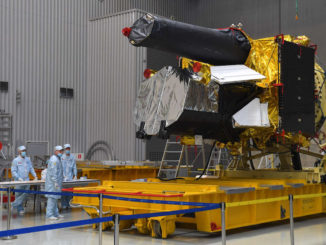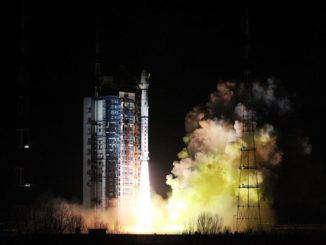Video credit: United Launch Alliance
A dramatic automatic abort 7.5 seconds before the planned liftoff of a United Launch Alliance Delta 4-Heavy rocket Saturday night kept the towering launcher on the pad at Vandenberg Air Force Base, California, with a top secret spy payload for the National Reconnaissance Office.
The 233-foot-tall (71-meter) rocket was counting down to launch at 8:15 p.m. PST Saturday (11:15 p.m. EST; 0415 GMT Sunday), but an automated sequencer detected a technical issue and triggered an abort.
“Hold hold hold,” a member of the ULA launch team declared on the countdown net.
A burst of flame appeared at the base of the rocket, a normal occurrence in the final seconds of a Delta 4 countdown as sparklers activate near the engines to burn off excess hydrogen gas before ignition, a measure aimed at eliminating the risk of a fireball or explosion.
It was not immediately clear whether any of the rocket’s three Aerojet Rocketdyne RS-68A main engines started their ignition sequences, but a statement later released by ULA said the computer-controlled countdown sequencer ordered an abort at T-minus 7.5 seconds.
In the statement, ULA said the abort was “due to an unexpected condition during terminal count at approximately 7.5 seconds before liftoff.
“The team is currently reviewing all data and will determine the path forward. A new launch date will be provided when available,” ULA said.
The Delta 4-Heavy is made up of three Delta 4 first stage boosters bolted together, each with an RS-68A engine burning liquid hydrogen and liquid oxygen propellants. ULA commands the three RS-68A engines to start in a staggered sequence, beginning with the starboard engine at T-minus 7 seconds, followed two seconds later by ignition of the center and port engines.
The timing of the abort at T-minus 7.5 seconds suggests the countdown stopped around a half-second before the first of the Delta 4-Heavy’s three main engines was supposed to ignite.
ULA’s launch team quickly “safed” the rocket, disarmed ordnance, and drained the Delta 4-Heavy of its supply of cryogenic propellants. The launch team did not set a new target launch date, but officials were instructed to plan for an extended turnaround after Saturday night’s scrub, and the Delta 4-Heavy flight was expected to be delayed at least a few days.
A similar cutoff in the final seconds of a Delta 4 countdown in 2010 resulted in a three-day slip to resolve the problem responsible for the abort — and replace the hydrogen burn-off sparklers on the pad — before the rocket successfully launched from Cape Canaveral with a GPS navigation satellite.
The upcoming mission from Vandenberg, located around 140 miles (225 kilometers) northwest of Los Angeles, is codenamed NROL-71 by the National Reconnaissance Office, which owns the U.S. government’s classified intelligence-gathering satellites. The NRO has not released any information about the spacecraft aboard the Delta 4-Heavy, but independent observers of NRO space launches believe the payload is heading for an unusual, high-inclination orbit, and is likely a new Keyhole-type high-resolution optical imaging satellite, with an Earth-pointing telescope capable of capturing extremely detailed imagery of sites around the world for review by government intelligence analysts.
The Delta 4-Heavy is ULA’s biggest rocket, and can loft up to 51,950 pounds (23,560 kilograms) of payload mass to a 120-mile-high (200-kilometer) low Earth orbit inclined 90 degrees to the equator.
The heavy-lift variant of the Delta 4 rocket has launched 10 times to date. The NROL-71 mission will be the 11th flight of a Delta 4-Heavy, and the 38th mission overall for the Delta 4 family since November 2002. It will also be ULA’s ninth and final launch of the year, following five Atlas 5 launches, a pair of Delta 4s, and the final liftoff of the company’s now-retired Delta 2 rocket.
A launch attempt for the NROL-71 mission Friday night was scrubbed after the Delta 4 team encountered a problem with a communications link between the control center and the rocket associated with the holdfire system.
Email the author.
Follow Stephen Clark on Twitter: @StephenClark1.



